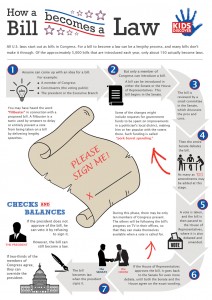 The Constitution’s Article I, Section 7 defines the process by which the federal government passes laws. Section 7 opens with the Origination Clause which requires “Bills for raising Revenue” to originate in the House of Representatives. The second clause and third clauses are known as both the “Presentment Clause” and “Lawmaking Clause”. The Presentment Clause is one of the Constitution’s most formal provisions. Lawmaking is the essence of government and to prevent the government from avoiding the constitutional process for passing laws, the Constitution defines the process in one of the document’s lengthiest provisions.
The Constitution’s Article I, Section 7 defines the process by which the federal government passes laws. Section 7 opens with the Origination Clause which requires “Bills for raising Revenue” to originate in the House of Representatives. The second clause and third clauses are known as both the “Presentment Clause” and “Lawmaking Clause”. The Presentment Clause is one of the Constitution’s most formal provisions. Lawmaking is the essence of government and to prevent the government from avoiding the constitutional process for passing laws, the Constitution defines the process in one of the document’s lengthiest provisions.
The Constitution’s Framers decision to require approval by the Senate, House and President before a proposal becomes law exemplifies the Framers’ judgments about harmonizing republican liberty, which generates laws from the general will of the people, with the practical need for stability in law to limit abrupt changes in social policy. The design allowed the law to change to reflect fluctuations in the will of the people, but in a way that involves consideration of many perspectives.
While Article I, Section 7 gives definition to the process of “lawmaking”, an organizational process has grown up around meeting the constitutional provisions.
Before there’s a law, there’s an idea. The idea may start with a Representative, Senator or citizen who has suggested the idea to a member of Congress.[1] If a Senator or Representative believes the idea should in fact be a law, he or she drafts a “bill” and discusses the idea with colleagues in an effort to gain their support. If other members agree the idea should be law they may join in proposing the law by becoming sponsors.
The Bill Is Introduced
In the U.S. House of Representatives, a bill is introduced by placement in the “hopper”, found at the Speaker’s platform. A Senator introduces a bill by placing it on the presiding officer’s desk or by formally introducing it on the Senate Floor. Only Representatives and Senators can introduce bills in their respective House of Congress.
When a bill is introduced, a bill clerk assigns it a number that begins with H.R. for the House and S. for the Senate. A reading clerk then reads the bill to all members and the bill to one of the congressional standing committees.
An electronic copy is sent to The Library of Congress and posts the bill and its status on THOMAS, a public website.
The Bill Goes to Committee
When the bill reaches committee, the committee members, members of Congress with expertise or interest in topics such as agriculture, education, or international relations, review, research, and possibly amend the bill before deciding whether the bill should be sent to the House or Senate floor for all members to vote on.[2]
If a committee approves a bill, it is sent, or reported to the full House or Senate for debate. The rules of debate vary greatly between the House and Senate
When a bill is debated, Members of Congress discuss the bill and explain why they agree or disagree with it. Then, a reading clerk reads the bill section by section and the Representatives or Senators may recommend changes or amendments.[3] When all changes have been made, the bill is ready to be voted on.
The Bill Is Voted Upon
If a majority of the Representatives or Senators voted to approve the bill, it is then certified by the Clerk and delivered to the other House.
When a bill reaches the other House it goes through a similar process as when first introduced. The bill is discussed in committee and reported to the floor to be voted on.
When both the Senate and House of Representatives have approved exactly the same bill, it is sent or “presented”[4] to the president.
The Bill Is Sent to the President
When a bill reaches the President, he has three choices. He can:
- Sign and approve the bill, and it becomes a law.
- Refuse to sign, or veto, the bill. The president sends the bill back to the House of Congress where it started, usually with a message detailing reasons for the veto. The Congress may “override” the veto if two-thirds of the Representatives and Senators vote to do this and the bill becomes a law.
- The president may do nothing. If Congress is in session the bill automatically becomes law after 10 days. If Congress is not in session, the bill does not become a law.[5]
The Bill Is a Law
If a bill has passed in both the U.S. House of Representatives and the U.S. Senate and has been approved by the President, or if a presidential veto has been overridden, the bill becomes a law. After all that, it will be the duty of the courts to “say what the law is”. Chief Justice John Marshall, Marbury v. Madison
School House Rock
For the video lovers, here’s the School House Rock version of this story:
___________________________________________________________________________________________________________
[1] The First Amendment right to Petition for Redress of Grievances once meant a duty of the legislature to formally consider citizen proposals. This has become a vestigial right.
[2] If the committee members would like more information before deciding if the bill should be sent to the House floor, the bill is sent to a subcommittee. A subcommittee may gather more information and expert opinions before the bill is returned to the full committee for approval.
[3] This process can become quite complex, and the most effective members know and understand these rules well.
[4] This is the source of the phrase “Presentment Clause”.
[5] This is called a pocket veto.








[…] How A Bill Becomes a Law: Article I, Section 7 of the Constitution […]